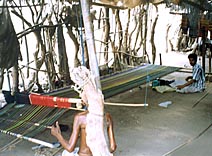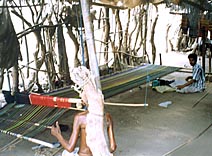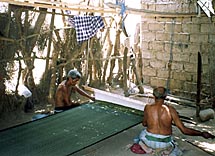
Weaving Handmade Carpets: A Handicraft that Needs our Care [Archives:1999/37/Culture]
September 13 1999
Saleh Abdulbaqi
Cultural Editor
T he Yemeni people have been very much related to the constituents and pillars of the economy, as well as civilization. One of these basic elements, which is very important and very much related to our past, is the national handicraft. This has given and reflected a nice picture of the ancient and deeply rooted civilization. These handicrafts once were the national pillars of our economy.

These crafts used to be the main way for these people to make a living. They were also a good source for economic, as well as cultural prosperity because we used to export such products to different countries in the east, as well as the west, where they met great fame and prevalence for their high standardization.
In this article, I would like to draw the attention to one of these handicrafts that used to be very important in our society. I was very much interested in this while being in Bait Al-Fakeeh, in Al-Hodaidah. I paid a visit to the National Factory for Weaving Carpets and Maawezes, Al-Hawool District.

Making Maawezes and carpets is very much related to the people in Bait Al-Fakeeh. They are actually very skilled in this activity and it seems they are still holding firm to it and will never give it up, though there is strong competition of similar products imported from other countries. For them these crafts are a very precious heritage they got from our ancestors. These tools are handmade from very cheap materials. In order to make these products, they depend highly on raw materials that are imported from India and China, which are actually very costly. As a matter of fact, the workers in this activity exert great efforts.
If you see them you would be amazed how they weave threads, which are mingled together in a very complex way. There are only four people working in this factory, each pair in a separate workshop. Their hands move quickly. When they work they seem to be like a bee hive, very busy with what they do. They sit on the ground all the time, working for long hours. “It seems to be a very tiring job, but we like it and will never give it up”, said one of the workers.
There are a number of organizations that are making use of these products to give a traditional atmosphere to their premises/buildings. The Yemenia Airlines, for instance, designed most of its carpets in this traditional way. Other public establishments, also are furnished from these products. This small factory is considered to be the only one that still exists from ten others that used to be there in the district.
This activity has tremendously attracted the attention of foreigners, in general, and tourists, in particular. Some of them kept standing for hours in a state of reverence, looking at these people and admiring their creation. We hope such handicrafts will not vanish and people in charge will do their uttermost to take care of our national heritage, that is on the wane.
——
[archive-e:37-v:1999-y:1999-d:1999-09-13-p:./1999/iss37/culture.htm]


